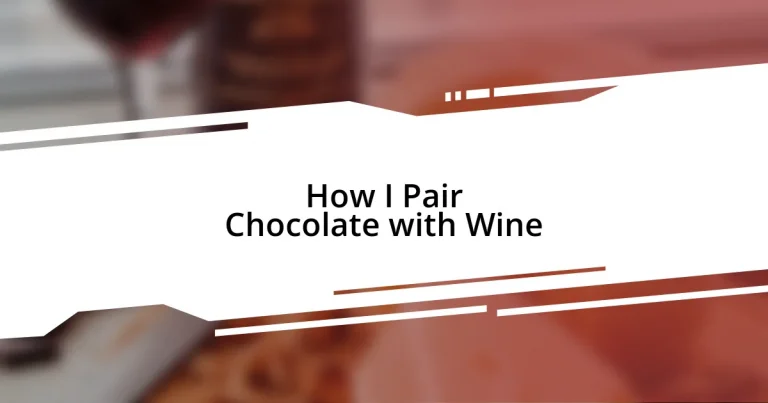Key takeaways:
- Choosing the right type of chocolate and wine is crucial for enhancing the pairing experience, with dark chocolate typically pairing well with bold reds, while milk chocolate complements lighter wines.
- Key principles for successful pairings include balance, similarity, and intensity, ensuring that both the chocolate and wine enhance each other’s flavors without overpowering.
- Common mistakes to avoid include mismatching intensity between chocolate and wine, assuming all sweet wines pair well with chocolate, and neglecting the impact of texture on the overall tasting experience.

Understanding chocolate types
When it comes to chocolate, the type you choose can truly make or break the pairing experience. Personally, I have a soft spot for dark chocolate, with its rich and complex flavor profile that perfectly complements the tannins in red wine. Have you ever savored a velvety piece of 70% dark chocolate while sipping a bold Cabernet Sauvignon? The way the flavors come together is simply sublime.
Milk chocolate, on the other hand, brings a creamier, sweeter vibe to the table. I remember indulging in a creamy milk chocolate bar after a long day; it was like a warm hug. This style of chocolate pairs well with lighter wines like Riesling or even some sparkling options. It’s fascinating how the sweetness of milk chocolate can soften the bite of acidity in wine, creating a lovely harmony.
Let’s not forget about white chocolate, which is technically not chocolate at all! I’ve found that the subtle, sweet characteristics of white chocolate can be intriguingly paired with sweet dessert wines. It’s a delightful option, but do you think it stands up against its darker counterparts? Personally, I think it offers a unique experience worth exploring, but it certainly requires careful consideration when picking the right wine.
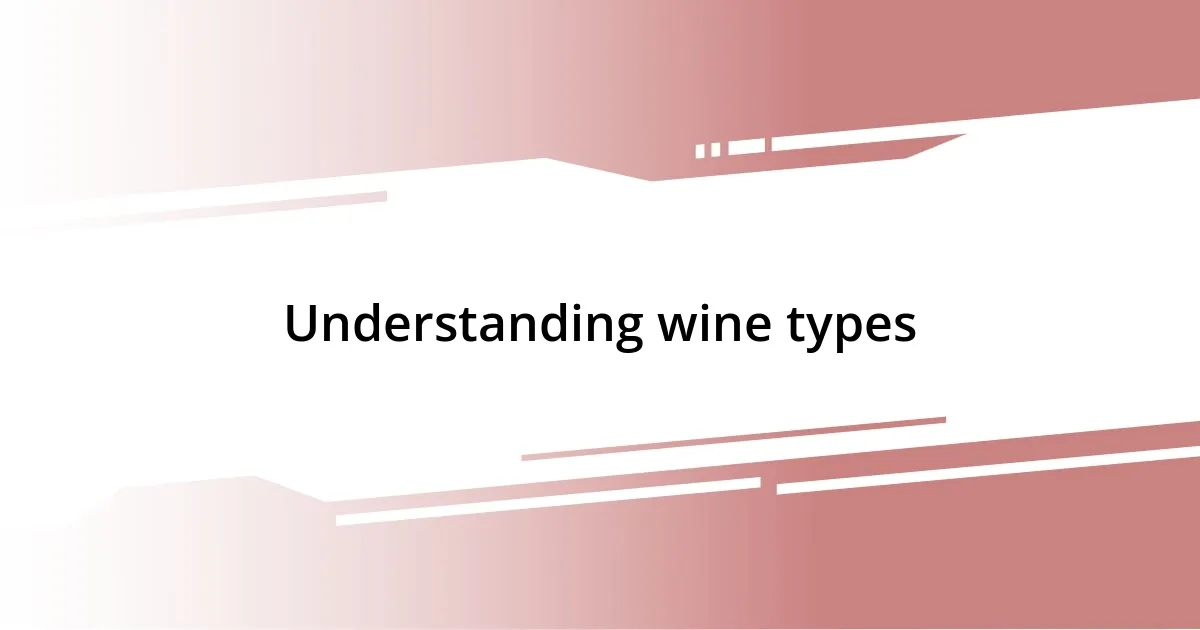
Understanding wine types
Understanding the different types of wine is essential for any successful pairing. I remember attending a wine tasting once, where a sommelier explained the characteristics of various wine types. It genuinely opened my eyes to how aspects like acidity, sweetness, and tannins affect flavor profiles. Here’s a quick breakdown to help you navigate:
- Red Wine: Generally bolder and richer, with varying levels of tannins. Varieties range from fruity Pinot Noir to robust Cabernet Sauvignon.
- White Wine: Usually lighter and crisper. Think of Chardonnay’s creaminess versus the refreshing notes of Sauvignon Blanc.
- Rosé: A delightful middle ground offering some fruitiness of red wine while retaining the lightness of white. Perfect for summer sipping!
- Sparkling Wine: Bursting with bubbles, this wine can span from dry to sweet, making it a versatile choice for pairing with chocolates.
- Dessert Wine: Rich and often sweet, these wines can complement chocolates, but they can also stand alone as a delightful treat.
Each type of wine offers a unique tasting experience. One evening, I paired a glass of Pinot Noir—light yet complex—with a piece of dark chocolate, and the combination was an explosion of flavor that danced on my palate. Finding the right type of wine can elevate chocolate from a simple treat to an extraordinary experience. When you consider these characteristics, it becomes easier to create exciting pairings that resonate with your personal preferences.
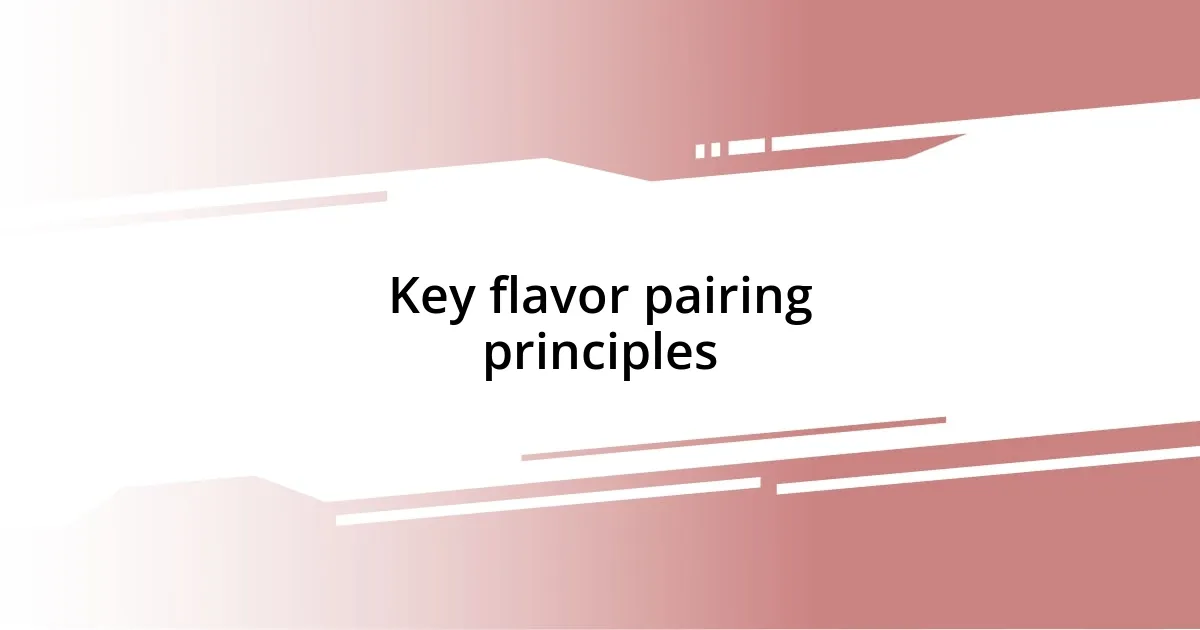
Key flavor pairing principles
When diving into the world of flavor pairings, a few key principles stand out. One of the most important is balance. I often think of this as a dance between the chocolate and wine; they should complement each other without overpowering one another. For instance, the deep, intense flavors of a high-cocoa dark chocolate may need a wine with bold tannins to match its richness, while a delicate milk chocolate can shine alongside a lightly sweet wine, creating a delightful contrast.
Another principle I rely on is the concept of similarity. Sometimes, when I enjoy a creamy chocolate truffle, I find that a round, buttery Chardonnay enhances the indulgence. The flavors mirror each other, creating a seamless tasting experience. It’s this kind of synergy that can leave a lasting impression. Have you ever noticed how certain pairings can evoke memories or feelings? That’s the magic of flavor connection.
Finally, it’s essential to consider intensity. Each element carries a different weight. When there’s an intense dessert, like a chocolate lava cake, I often select a robust Port or a rich Malbec. This harmony of intensity ensures that neither the chocolate nor the wine seems lacking. Too many times, I’ve had experiences where the wine felt ‘lost’ against an overpowered dessert, and I learned the importance of choosing wisely to avoid such disappointments.
| Principle | Description |
|---|---|
| Balance | Ensuring both chocolate and wine complement each other without overwhelming one another. |
| Similarity | Choosing flavors that mirror each other to create a harmonious pairing experience. |
| Intensity | Selecting wines and chocolates of similar intensities to maintain a cohesive flavor interaction. |
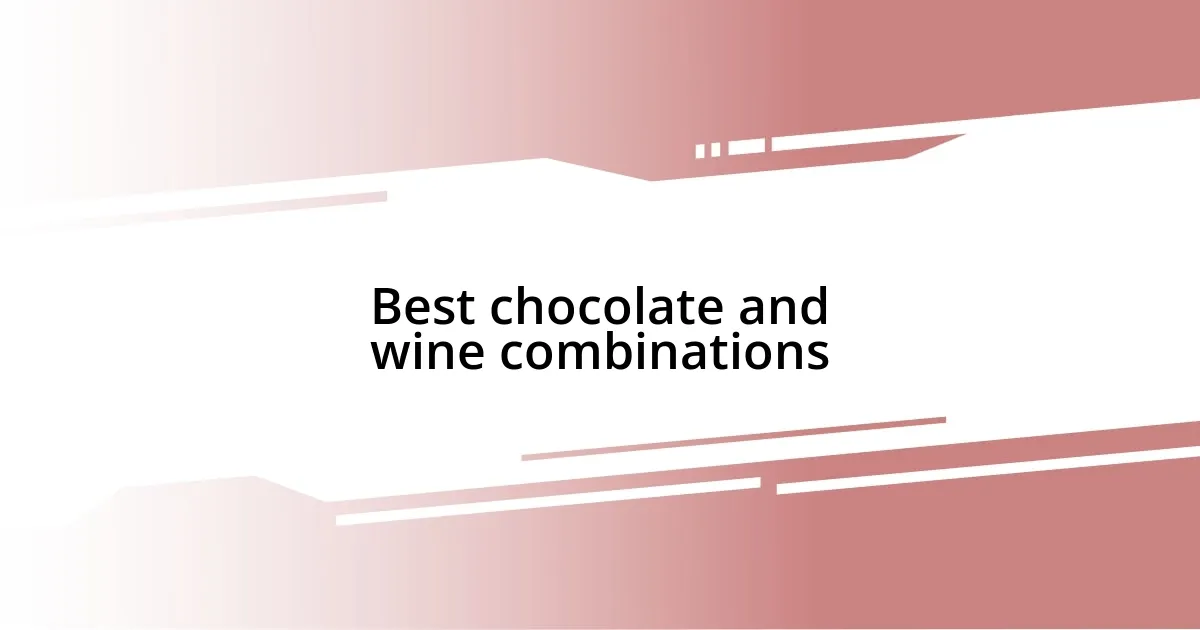
Best chocolate and wine combinations
When exploring the best chocolate and wine combinations, my top recommendation is pairing a dark chocolate with a full-bodied Cabernet Sauvignon. The blend of deep cocoa and bold fruit flavors creates a remarkable journey for your taste buds. I still remember the first time I tried this pairing—each sip of wine would seem to highlight the rich notes of the chocolate, making my evening feel like a special occasion.
For a lighter option, I often find that milk chocolate pairs beautifully with a creamy Chardonnay. The wine’s buttery notes wrap around the chocolate, creating an irresistible harmony. I once shared this pairing with a friend during a cozy movie night, and the smiles on our faces spoke volumes; it was as if we had uncovered a hidden treasure together.
If you’re adventurous, trying a spicy Zinfandel with chocolate-covered cherries might surprise you. The wine’s peppery notes complement the sweetness of the cherries and the richness of the chocolate. I vividly recall a gathering where this combination stole the show, leaving everyone asking for more. Have you ever tasted something that just felt so right? That’s the essence of finding your perfect pairing!
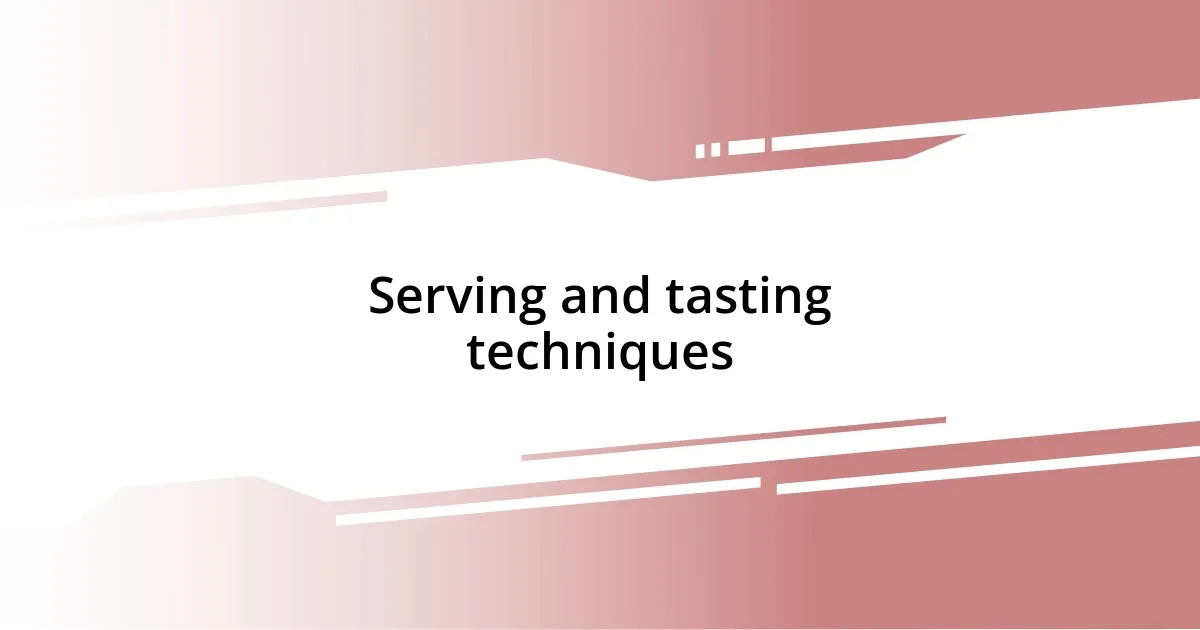
Serving and tasting techniques
When it comes to serving chocolate and wine, I’ve found that presentation can elevate the experience. For instance, I enjoy laying out a cheese board-style arrangement with various chocolates and wine glasses, allowing guests to explore the pairings themselves. It invites conversation and creates a relaxed, interactive atmosphere—much like a mini-tasting party right in your living room!
To truly appreciate the nuances of each pairing, I suggest taking a moment to savor the scents before tasting. The aroma always compels me to think about the flavor journey ahead. It’s a delightful practice; just the other evening, I took a moment with a piece of dark chocolate infused with sea salt. The fragrance alone triggered memories of sunlit beach days, enhancing the overall experience. Have you ever paused to inhale the aromas of your food? It can profoundly deepen the tasting moment.
Lastly, I’ve learned that the order in which you taste matters. When I host tastings, I like to start with lighter chocolates—like white chocolate or milk chocolate—before progressing to darker varieties. This approach helps your palate adapt, making each subsequent tasting feel like it builds upon the last. I remember the first time I tried this method; the transition from a sweet caramel chocolate to a bold, rich truffle was nothing short of magical, leaving a lasting impression of seamless flavor evolution.

Expert tips for enhancing pairings
To elevate your chocolate and wine pairings, consider the texture of both elements. For instance, I recently paired a silky dark chocolate mousse with a velvety Merlot. The luxurious mouthfeel harmonized beautifully, allowing me to appreciate both the wine’s smooth tannins and the chocolate’s rich creaminess. Isn’t it fascinating how the texture can enhance the overall tasting experience?
One tip I swear by is not to overlook regional pairings. The first time I attended a wine festival, I discovered a local chocolate maker whose dark chocolate was crafted with grapes from the vineyard producing exquisite wine. The synergy was undeniable; it felt like experiencing the essence of the region in each bite and sip. Have you ever discovered a local pairing that surprised you? It’s a journey worth taking!
Lastly, don’t hesitate to experiment with flavors beyond the conventional. I once tried pairing a spicy chili-infused chocolate with a refreshing Riesling and was blown away by the contrast. The sweetness of the wine cut through the heat, creating a delightful balance. What’s more thrilling than discovering unexpected combinations that turn your taste buds upside down? The thrill of experimentation can lead to some truly unforgettable moments at your next gathering.
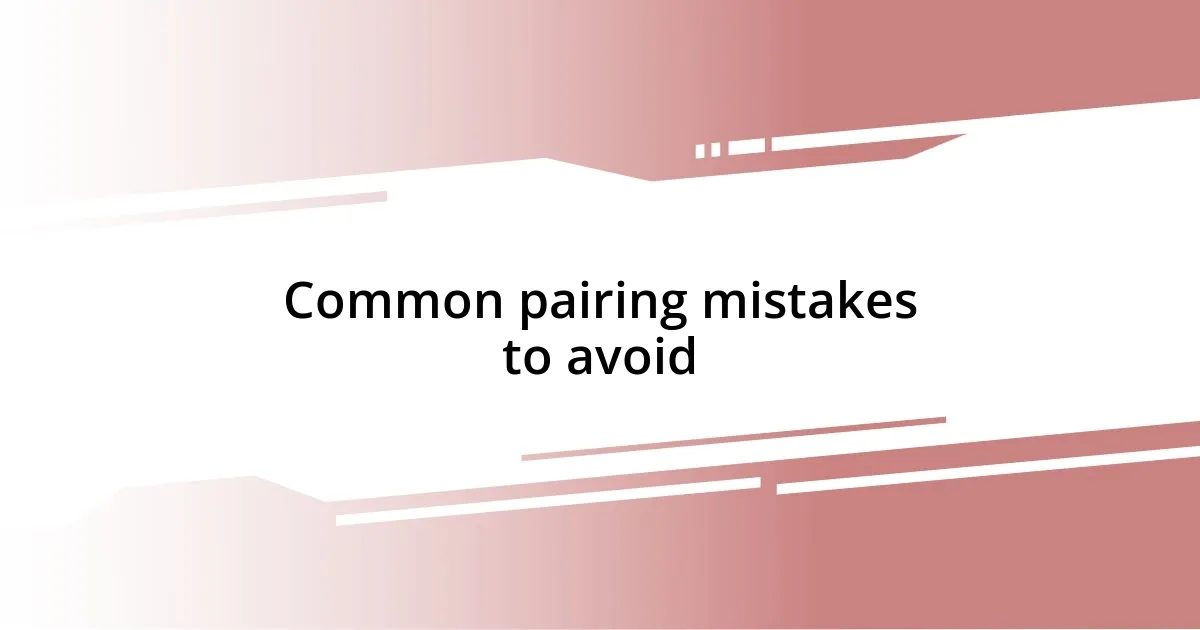
Common pairing mistakes to avoid
One common mistake I’ve seen is pairing chocolates and wines that are mismatched in intensity. For example, I once paired an incredibly rich, dark chocolate with a light, fruity wine. The flavors were completely overshadowed, leaving me disappointed. It’s like trying to enjoy a whisper in a loud room—both need to be in harmony for the music to truly resonate. Have you ever experienced a pairing that just didn’t sing?
Another pitfall is assuming that all sweet wines go well with chocolate. I learned this the hard way when I tried a dessert wine with a chocolate that had a robust bitterness. Instead of a harmonious blend, the tasting became a battle, each trying to outdo the other. The next time you explore sweet wines, consider their acidity and flavors, just as you’d pay attention to the chocolate’s profile. What’s the point of tasting, if not to find balance and joy in each bite and sip?
Lastly, many people overlook the importance of textures in their pairings. I used to think that any chocolate would go with any wine, until I paired a crispy toffee chocolate with a creamy dessert wine. The contrast in textures was jarring, rather than complementing. It’s essential to consider how the wine’s mouthfeel interacts with the chocolate. Have you ever thought about how a silky chocolate might just call for a wine with a bit more grip? Finding that synergy can elevate your tasting experience to new heights.












